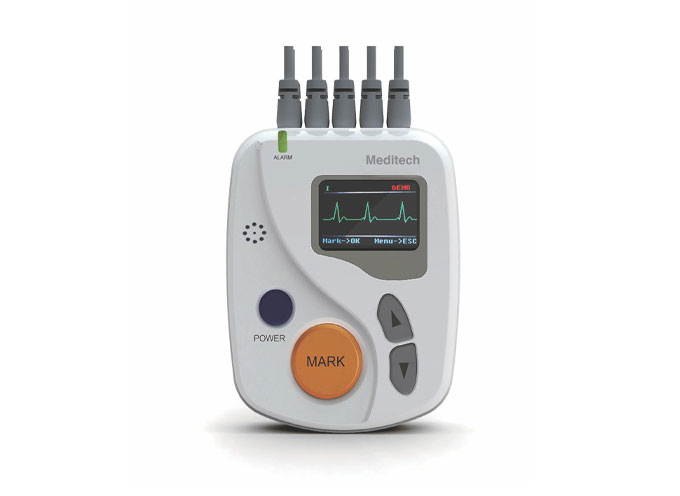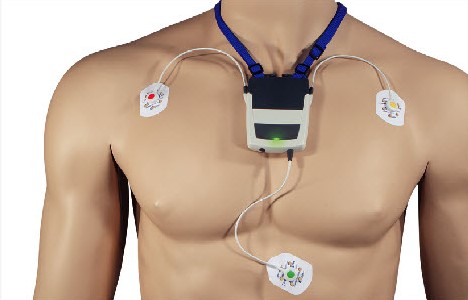# The Topic
A heart rate monitor (HRM) is a personal monitoring device that measures heart rate in real-time or records the heart rate for later study. It is commonly used to collect heart rate data while performing various types of activity which are part of the patient’s day-to-day life. Portable medical devices are referred to as Holter Monitor which is designed for everyday use and does not use wires to connect.
Modern heart rate monitors commonly use one of two different methods to record heart signals: electrical and optical. Both types of signals can provide the same basic heart rate data, using fully automated algorithms to measure heart rate.
_ Electrical Devices: The electrical monitors consist of two elements: a monitor/transmitter, which is worn on a chest strap, and a receiver. When a heartbeat is detected a radio signal is transmitted, which the receiver uses to display/determine the current heart rate. This signal can be a simple radio pulse or a unique coded signal from the chest strap.
_ Optical Devices: More recent devices use optics to measure heart rate by shining light from an LED through the skin and measuring how it scatters off blood vessels. Smartwatches and cell phones can be included within this category, but their use for medical purposes is limited even though the accuracy in detecting several diseases increased significantly in recent years. Many professionals recommend anyway their use as support in data collection processes.
# Holter Monitor
A Holter monitor is a small, wearable device that keeps track of your heart rhythm. The doctor may want the patient to wear a Holter monitor for one to two days. During that time, the device records all heartbeats. This procedure can be repeated several times if the medical practitioner requires it to accomplish the goal of the overall study.
A Holter monitor test may be done if a traditional electrocardiogram (ECG) doesn’t deliver enough information about the heart’s condition. A Holter monitor may be able to spot occasionally abnormal heart rhythms that an ECG missed due to the short time that the patient is hooked up to the machine. The medical practitioner uses information captured on the Holter monitor to figure out if the patient has e a heart rhythm problem or a heart condition that increases your risk of an abnormal heart rhythm.
# What Patients say:
After interviewing two patients who had to wear the Holter monitor due to different heart conditions, plus the information collected in different clinical studies, these would be the most significant insights referring to the patient experience:
_ Most of the patients found the device uncomfortable. Sometimes, some of their daily activities were difficult to carry out due to the device.
_ Some patients had difficulty putting the device back on after showering. Due to this, the collected data wasn’t accurate.
_ Even though the majority of patients expressed full trust in their doctors, many did not feel involved in the process. They simply had to “follow orders” but did not understand what kind of data was being measured.
_ Some patients experienced a feeling of vulnerability when they gave the device back to their medical facility. Although the device was uncomfortable to wear, it made them feel safe, assuming that their heart was being controlled. Once they removed it, that feeling of security disappeared.
_ Some patients experienced skin allergies due to the adhesive tape on the device.
# What Doctors say:
After interviewing a cardiology physician and a general practitioner, I was able to gather the following insights:
_ It is difficult to ensure successful measurements with elderly patients due to the technical requirements of the device. The majority of patients using this device are older than 60 and sometimes they need to repeat the procedure more than once.
_ Although the device collects valuable information, some conditions, which might be symptoms of more serious heart problems, go unnoticed. (ex. certain types of arrhythmias).
_ They get frustrated because they cannot find the time to explain all the details of the procedure to their patients and they feel patients’ dissatisfaction and uncertainty.
_ “It takes too long to get the data that we need”. Patients must return the device back to the medical center, then the technicians extract the data from the device by connecting it to their system, then the data are included within the patient’s records and saved in databases. Only then doctors are able to have a clear vision of what is going on with their patients.
# Compared with other Devices for Heartbeat Monitoring:
Despite the fact that the Holter monitor is one of the most used devices to measure the heartbeat even today, for a few years, other heartbeat monitors have been coming onto the market offering significant improvements for patients. This is the case of Zio Patch, from iRythm Tech.
But even though this new monitoring option is more manageable, less cumbersome, and has a higher level of data accuracy than the original Holter Monitor, it requires longer use than the Holter Monitor to detect the same number of conditions. This makes procedures a bit harder to perform with both children and the elderly.
As mentioned before, many smartwatches and mobile phones can provide a service similar to heartbeat monitors but are not capable of perceiving certain abnormalities that may indicate heart problems. They are a very good aid for home use because they measure many different parameters such as oxygen saturation, thanks to the use of sensors including accelerometers, gyroscopes, and GPS.
# Conclusions and Challenges
Finding the ideal device is not easy. Both patients and medical professionals have needs that should be met in order to succeed when going through these procedures, and it seems that if you try to improve one part, the other will get worse.
For me, the main challenge is to rethink the design of the device. It is clear to me, that it needs to be something free of technical assistance. The ease of use must be a basic requirement due to the characteristics of the patients who generally use this type of device.
On the other hand, it should offer some kind of interface that could deliver clear information to patients, making them understand what data is being collected. This is already offered on smartphones or smartwatches.
And last but not least, the data collection. The more accurate data collection in the shortest possible time, the medical professionals will be able to deliver better diagnoses in less time. In this way, they will be able to care about the psychological needs of patients before, during, and after the procedures. In my opinion, finding a way to shorten the process from data collection until professionals can access and evaluate this data, should be a priority.
# References:
https://www.healthline.com/health/holter-monitor-24h#results
https://www.mayoclinic.org/tests-procedures/holter-monitor/about/pac-20385039
https://medicompinc.com/introducing-newly-improved-holter-monitoring-system-medicomp/

